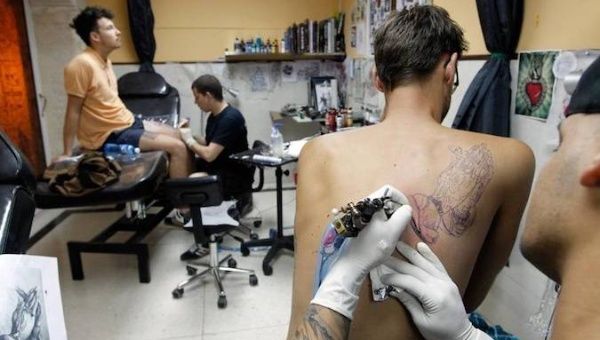Cuba Defies US Blockade with Booming Tattoo Trade

The steady flow of people either looking to get some fresh ink or to browse the exhibits is evidence something is changing. | Photo: EFE/File photo
Published 28 February 2020
Punters, mostly young and covered in ink, revel in the novelty of having tattoo masters gathered under one roof.
The humming of tattoo machines fills the second floor of the Cuban Art Factory (FAC) in Havana in which participated hundreds of attendees at Pura Aguja, the first multidisciplinary body art event in Cuba.
RELATED:
U.S. Blockade Hinders Organ Transplant Process in Cuba
The former oil factory converted into a cultural center welcomes some 30 artists from across the island for three days, together with guests from Mexico and the United States who offer live demonstrations of tattoos and piercings.
“A super event!”16-year-old Jose says excitedly.
Needles fly over armchairs and stretchers wrapped in plastic as curious crowds gather round.
Nearby, several brands showcase their products, including Afro-Cuban-inspired clothing and jewelry line Beyond Roots, and D’Brujas a small brand of handmade soaps used for tattoo aftercare.
“We believe that it is the first of its kind because it is not an event or an exhibition only about tattoos, but body art in general. We have tried to gather a sample of the best in Cuba.
“We have piercings, essential oils for the skin, henna and participants from several provinces of the country,” Ailed Duarte, organizer of Pura Aguja, told EFE.
In January 2015, Duarte launched a collective of visual artists with her husband, veteran tattoo artist Leo Canosa and the La Marca gallery workshop – the first professional tattoo studio in Cuba.
Pura Aguja organizers work together on strategies to help institutionalizing the profession within the wider arts scene in the country.
According to Duarte, “exhibiting everything from an artistic point of view, with the hygienic measures involved and the responsibility that must be assumed,” is a way of pushing for that recognition.
Nguyen Rodriguez, of the Art Factory team, says workshops and conferences included in this “experiment” also reaffirm the interest of artists to learn, which has cemented FAC as a hub of creativity.
“The evolution that (the tattoo) has had all over the world, but especially in Cuba, where there are fewer things is impressive,” says the visual artist and tattoo artist Doktor Lakra.
The chronic shortage of goods on the island induced by the U.S. blockade, which stirs almost all areas of Cuban life, also affects tattoo studios, who depend on shipments from abroad or the goodwill of friends and colleagues, who travel with suitcases bursting with ink, needles and disposable gloves.
Doktor Lakra, who offered a conference on the origins and symbology of tattoo in prison, said “It is important, not only for tattooists but for people who get tattooed because it changes the general vision that there is a stigma about this world. These kinds of events help that.”
Although men still monopolize the market, women are slowly making their way into the profession.
In Risink Tattoo, only women are behind the needles.
“We are super happy that women have also been encouraged to join this movement that throughout history was more associated with men. In Pura Aguja we have four of them, so welcome women to tattoo,” Ailed Duarte said.
No comments:
Post a Comment